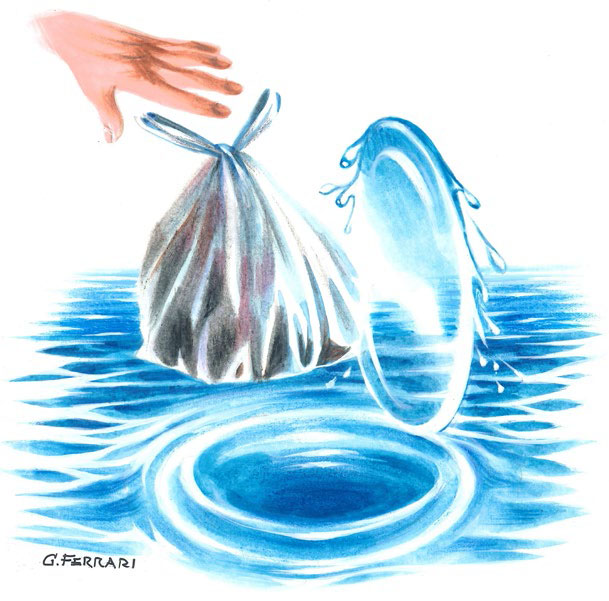20,000 tons under the sea
Publish date 13-01-2024

World Environment Day 2023 (UNEP-UN) was dedicated to plastic with this slogan: #BeatPlasticPollution, "searching for solutions to combat plastic pollution".
UN Secretary Guterres: «governments, businesses and consumers need to work together to break the dependence on plastic. The pressure on ecosystems is enormous." The UN world assembly on plastics has just ended in Nairobi: a historic revolution for 175 countries.
It is the beginning of a path that commits to reaching a binding international agreement against the excessive spread of plastic by 2024. Fingers crossed!
Let us recall some essential data on the topic. Plastic is the third most widespread artificial material on the planet after steel and concrete. From 1950 to today, 8.3 billion tons of plastic materials have been produced. Very high production, very high waste in nature, especially disposable packaging. There are no longer any pristine places on the planet.
Every year it is estimated that around 8 million tonnes of plastic ends up in the seas and oceans.
The European Union has defined a lot: mandatory recycling objectives, laws that reduce and prohibit disposable materials, biodegradable and compostable substitute materials... but it is not enough.
Because plastics cause visible and invisible pollution such as microplastics and microfibres. Plastic is a non-biodegradable material, but it can degrade at a microscopic level.
Microplastics range from 5 mm to 1 micron: a thousandth of a millimeter – 500 times smaller than a grain of sand.
This is why we talk about "invisible". In the sea, there are 170 thousand billion plastic particles arriving mostly from the mainland, weighing 2.3 billion tonnes. Plastics in the sea (on the surface and on the bottom) will soon end up weighing more than all the fish in the sea. The risk to organismal health due to microplastics is undeniable. First, for direct or indirect ingestion by organisms. Then, for the absorption of chemical substances with toxic properties transferable to living tissues. Finally, plastics are carriers of heavy metals and fluorescent bleaching substances. The Polytechnic of Turin has departments and working groups that analyze microplastics in the Arctic, in Alpine glaciers, in caves, in rivers and in the Mediterranean Sea (Plastics is also the title of an interactive exhibition exhibited in November in Casale Monferrato and which will then will move to Novi Ligure between January and February).
As for Italy, the annual CONAI report has just been released, which deals with separate collection for recycling (to be confirmed with ISPRA data).
Paper and glass are fine, plastic is collected, but then it has problems in the supply chain, as is moisture. However, Italy (apart from the central-south) is doing well: we have brought forward the European deadlines for 2030. However, we cannot rejoice. It is enough to know the data and the difficulties of the plastic supply chain and you immediately understand that recycling is only one of the paths to follow, others such as prevention must also be followed. Plastic waste (the famous packaging) collected separately amounted to 1,160,000 tonnes. The plastic recycling supply chain in Italy is made up of around 75 companies concentrated mainly in northern Italy. European law establishes that by 2025 all bottles contain at least 25% recycled material and that in 2029 90% of the bottles produced must be collected. However, it must be remembered that not all of the PET collected can be used again for bottles, a large part will be used for other uses because it has deteriorated.
In conclusion: it is necessary not to consume products with too much packaging, because we can very well do without it (it is up to us consumers to carefully choose what to buy, limit consumption and reuse). The consequence will be a reduction in high production.
An advantage for the whole world, also given the lack of commitment in this sense by many countries in the former South of the world. Let's talk about us: the average Italian consumer does not consciously choose products with less plastic. In 2022, food bags and trays grew by 19%; food wraps by 13%. The Plastic tax, defined in the 2020 budget law, has been suspended by this government "until a later date".
It is best not to be distracted from the concept of plastic prevention. Unfortunately, the diffusion and consumption of bottled mineral water has increased by 30%, without there being any real need. There are still too many families who don't trust drinking tap water, although they are decreasing: from 40.1% in 2002, the figure has fallen to 29%. They range from 17.8% in the north-east to 52% in the islands and 45% in Calabria (ISTAT data).
Data that reminds us that our environmental culture and our habits are one cards to play immediately to achieve important results, such as reducing the unjustified use of disposable plastic in the water we drink.
Carlo Degiacomi
NP December 2023







